Influence of Guide Vane Slope on Axial-Flow Hydraulic Performance and Internal Flow Characteristics
Abstract
:1. Introduction
2. Materials and Methods
2.1. Geometric Models
2.2. Model Setup
3. Results and Discussion
3.1. Experimental Verification
3.2. External Characteristic Analysis
3.3. Analysis of Inflow Characteristics
4. Conclusions
Author Contributions
Funding
Institutional Review Board Statement
Informed Consent Statement
Data Availability Statement
Conflicts of Interest
Nomenclature
| k | Slope of the guide vane [-] |
| Δh | Height difference of the impeller outlet from the hub to the rim [mm] |
| rs | Radius of the guide vane shroud [mm] |
| rh | Radius of the guide vane hub [mm] |
| H | Pump head [m] |
| P1 | Total pressure of the pump inlet [Pa] |
| P2 | Total pressure of the pump outlet [Pa] |
| PA | Shaft power [W] |
| Pe | Effective power [W] |
| v1 | Velocity of the pump inlet [m/s] |
| v2 | Velocity of the pump outlet [m/s] |
| Q | Flow rate [m3/s] |
| Qd | Design flow rate [m3/s] |
| g | Gravity [m/s2] |
| η | Efficiency [%] |
| ρ | Density [kg/m3] |
| n | Rotating speed [r/min] |
| ns | Specific speed [rad·m3/4/s3/2] |
| TA | Torque [N·m] |
| Subscripts | |
| 1 | Pump inlet |
| 2 | Pump outlet |
| s | Shroud |
| h | Hub |
References
- Yang, F.; Zhao, H.R.; Liu, C. Improvement of the Efficiency of the Axial-Flow Pump at Part Loads due to Installing Outlet Guide Vanes Mechanism. Math. Probl. Eng. Theory Methods Appl. 2016, 2016 Pt 2, 6375314. [Google Scholar] [CrossRef]
- Zhang, H.; Shi, W.D.; Bin, C.; Zhang, Q.H.; Cao, W.D. Experimental study of flow field in interference area between impeller and guide vane of axial flow pump. J. Hydrodyn. Ser. B 2015, 26, 894–901. [Google Scholar] [CrossRef]
- Qian, Z.; Wang, Y.; Huai, W.; Lee, Y. Numerical simulation of water flow in an axial flow pump with adjustable guide vanes. J. Mech. Sci. Technol. 2010, 24, 971–976. [Google Scholar] [CrossRef]
- Yun, J.E. CFD Analysis for Optimization of Guide Vane of Axial-Flow Pump. Trans. Korean Soc. Mech. Eng. B 2016, 40, 519–525. [Google Scholar] [CrossRef]
- Park, H.C.; Kim, S.; Yoon, J.Y.; Choi, Y.S. A Numerical Study on the Performance Improvement of Guide Vanes in an Axial-flow Pump. KSFM J. Fluid Mach. 2012, 15, 58–63. [Google Scholar] [CrossRef]
- Horlock, J.H. The Use of Circumferentially Varying Stagger Guide Vanes in an Axial Flow Pump or Compressor. J. Turbomach. 1990, 112, 360–363. [Google Scholar] [CrossRef]
- Kim, Y.; Shim, H.S.; Kim, K.Y. Hydraulic Performance Characteristics of a Submersible Axial-Flow Pump with Different Angles of Inlet Guide Vane. J. Korean Soc. Fluid Mach. 2018, 21, 34–40. [Google Scholar]
- Kim, S.; Choi, Y.S.; Lee, K.Y.; Kim, J.H. Interaction of impeller and guide vane in a series-designed axial-flow pump. IOP Conf. 2014, 15, 2027. [Google Scholar] [CrossRef]
- Qian, Z.; Wang, F.; Guo, Z.; Lu, J. Performance evaluation of an axial-flow pump with adjustable guide vanes in turbine mode. Renew. Energy 2016, 99, 1146–1152. [Google Scholar] [CrossRef]
- Mosbahi, M.; Ayadi, A.; Chouaibi, Y.; Driss, Z.; Tucciarelli, T. Experimental and numerical investigation of the leading edge sweep angle effect on the performance of a delta blades hydrokinetic turbine. Renew. Energy 2020, 162, 1087–1103. [Google Scholar] [CrossRef]
- Xu, L.; Ji, D.; Shi, W.; Xu, B.; Lu, W.; Lu, L. Influence of Inlet Angle of Guide Vane on Hydraulic Performance of an Axial Flow Pump Based on CFD. Shock Vib. 2020, 2020, 8880789. [Google Scholar] [CrossRef]
- Yang, F.; Hu, W.Z.; Li, C.; Liu, C.; Jin, Y. Computational study on the performance improvement of axial-flow pump by inlet guide vanes at part loads. J. Mech. Sci. Technol. 2020, 34, 4905–4915. [Google Scholar] [CrossRef]
- Li, G.; Chen, E.; Yang, A.; Xie, Z.; Zhao, G. Effect of Guide Vanes on Flow and Vibroacoustic in an Axial-Flow Pump. Math. Probl. Eng. 2018, 2018 Pt 14, 3095890. [Google Scholar] [CrossRef]
- Al-Obaidi, A.R. Influence of guide vanes on the flow fields and performance of axial pump under unsteady flow conditions: Numerical study. J. Mech. Eng. Sci. 2020, 14, 6570–6593. [Google Scholar] [CrossRef]
- Pu, K.; Huang, B.; Miao, H.; Shi, P.; Wu, D. Quantitative analysis of energy loss and vibration performance in a circulating axial pump. Energy 2022, 243, 122753. [Google Scholar] [CrossRef]
- Kan, K.; Zheng, Y.; Chen, Y.; Xie, Z.; Yang, G.; Yang, C. Numerical study on the internal flow characteristics of an axial-flow pump under stall conditions. J. Mech. Sci. Technol. 2018, 32, 4683–4695. [Google Scholar] [CrossRef]
- Kaya, D. Experimental study on regaining the tangential velocity energy of axial flow pump. Energy Convers. Manag. 2003, 44, 1817–1829. [Google Scholar] [CrossRef]
- Liu, Y.; Han, Y.; Tan, L.; Wang, Y. Blade rotation angle on energy performance and tip leakage vortex in a mixed flow pump as turbine at pump mode. Energy 2020, 206, 118084. [Google Scholar] [CrossRef]
- Guo, Z.; Pan, J.; Qian, Z.; Ji, B. Experimental and numerical analysis of the unsteady influence of the inlet guide vanes on cavitation performance of an axial pump. Proc. Inst. Mech. Eng. Part C J. Mech. Eng. Sci. 2018, 233, 095440621880911. [Google Scholar] [CrossRef]
- Zhao, X.; Liu, T.; Huang, B.; Wang, G. Combined experimental and numerical analysis of cavitating flow characteristics in an axial flow waterjet pump. Ocean. Eng. 2020, 209, 107450. [Google Scholar] [CrossRef]
- Pengfei, M.A.; Wang, J.; Wang, H.F. Investigation of performances and flow characteristics of two bi-directional pumps with different airfoil blades. Sci. China (Technol. Sci.) 2018, 61, 1588–1599. [Google Scholar]
- Hong, G.; Lin, W.; Ye, F. An Investigation of the Flow and Global Performance in a Water-Jet Axial Flow Pump Based on CFD and Inverse Design Method. In Proceedings of the Asme Fluids Engineering Division Summer Meeting, Houston, TX, USA, 19–23 June 2005. [Google Scholar]
- Furukawa, A.; Watanabe, S.S. Performance test and flow measurement of contra-rotating axial flow pump. J. Therm. Sci. 2007, 16, 7–13. [Google Scholar] [CrossRef]
- Gao, H.; Lin, W.; Du, Z. Numerical flow and performance analysis of a water-jet axial flow pump. Ocean. Eng. 2008, 35, 1604–1614. [Google Scholar] [CrossRef]
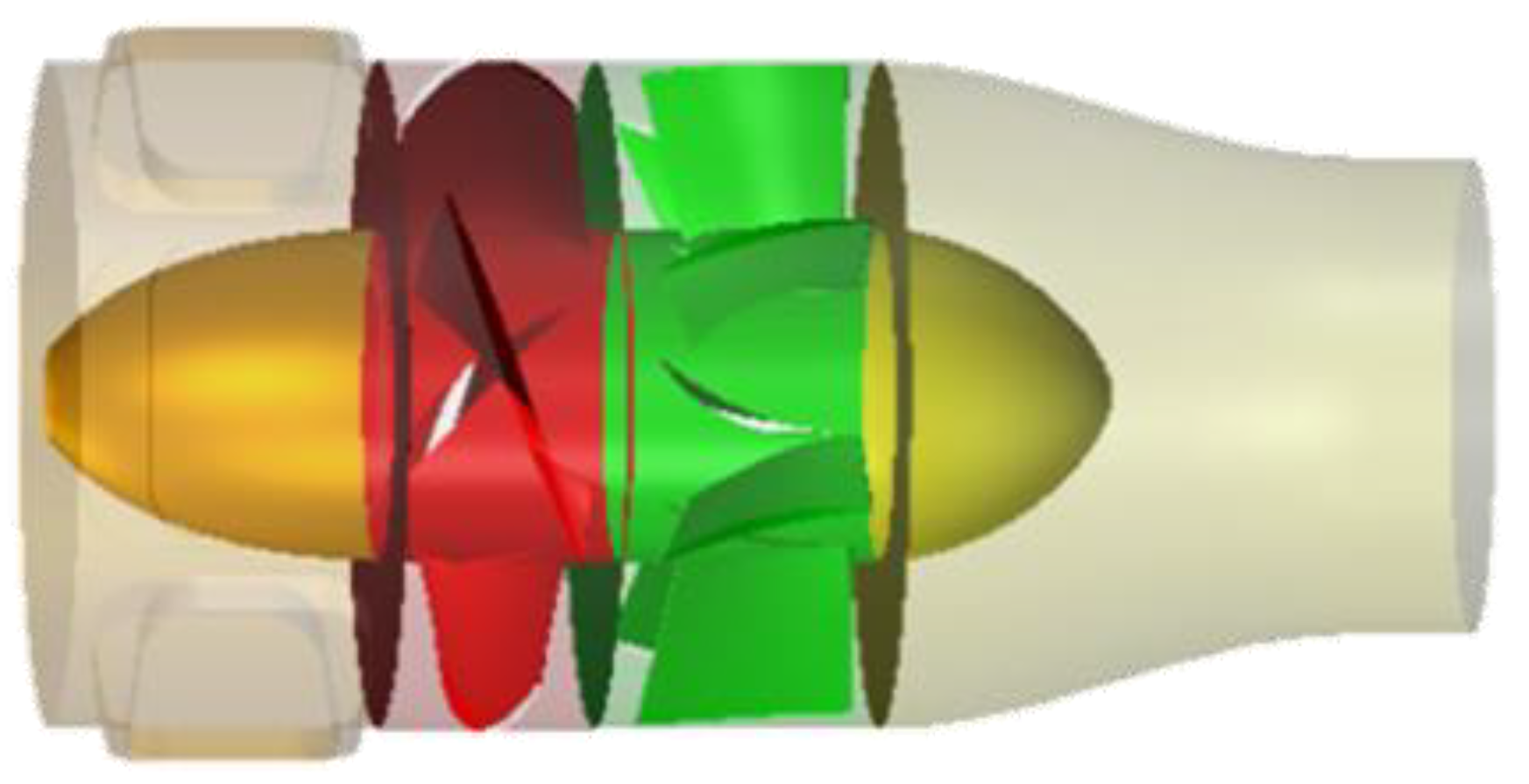
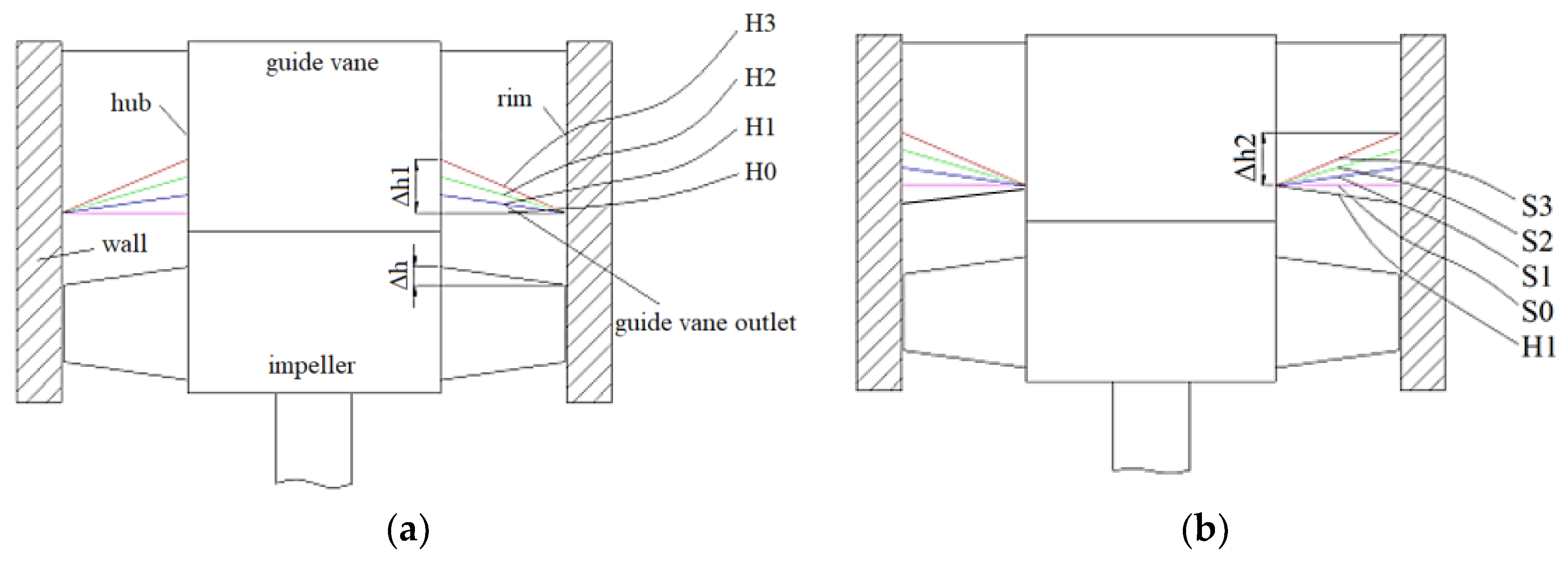
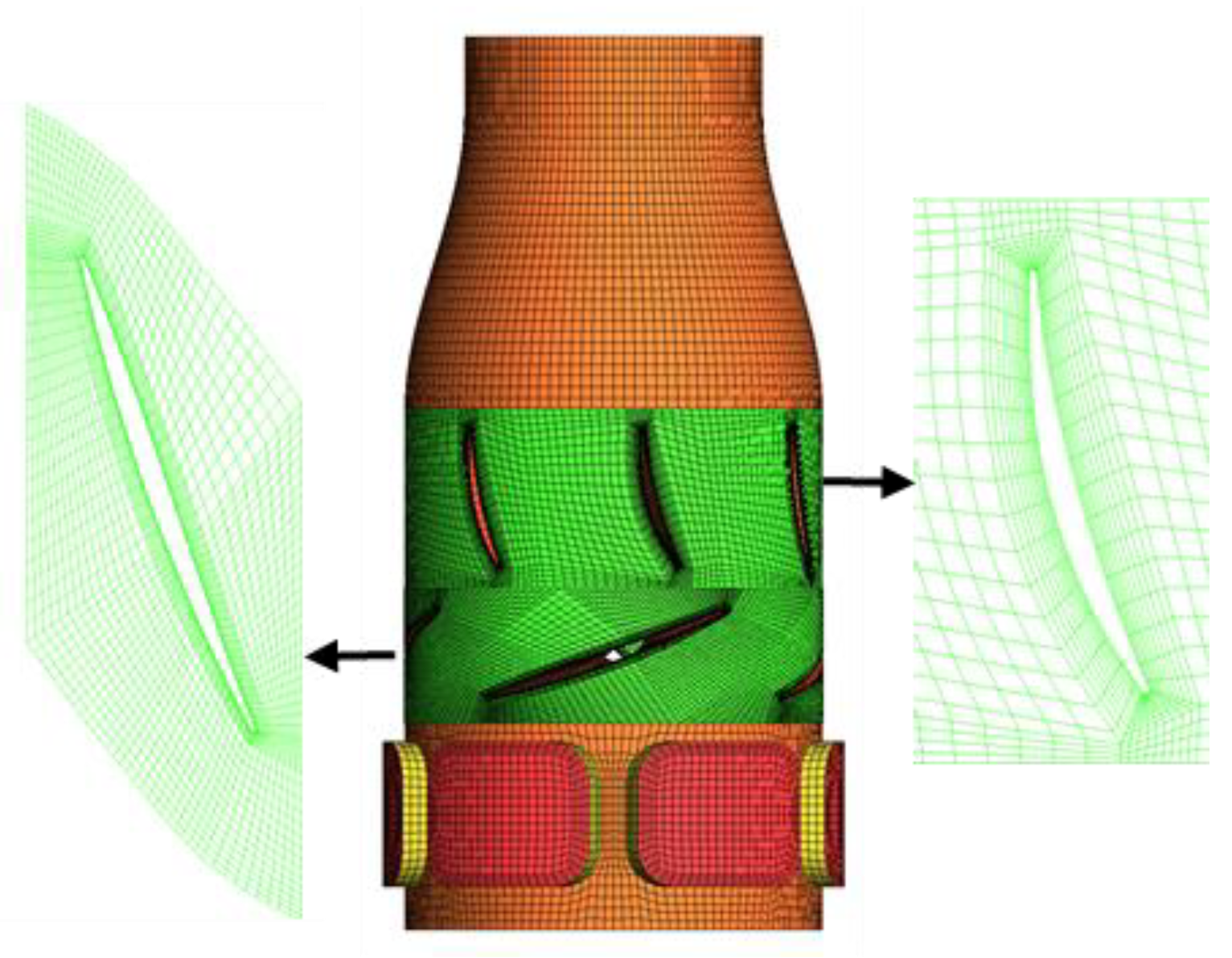
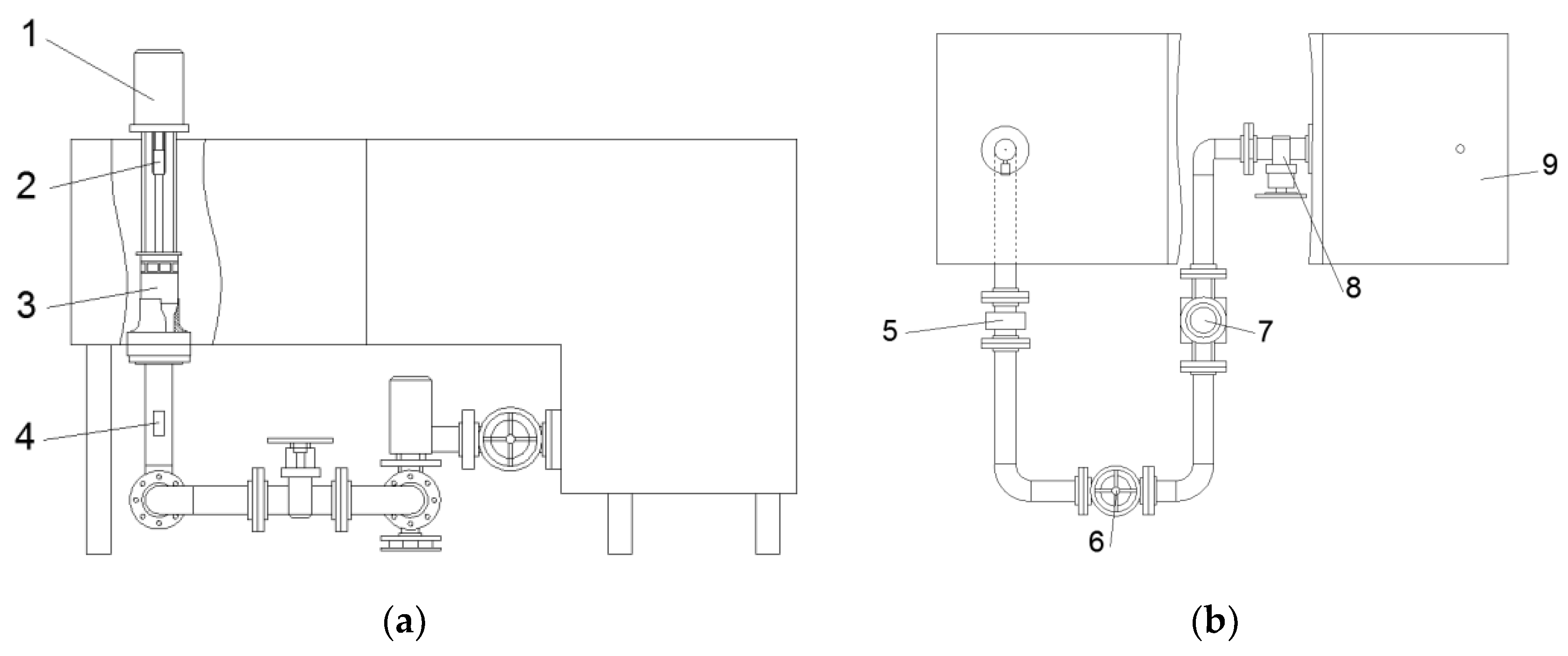
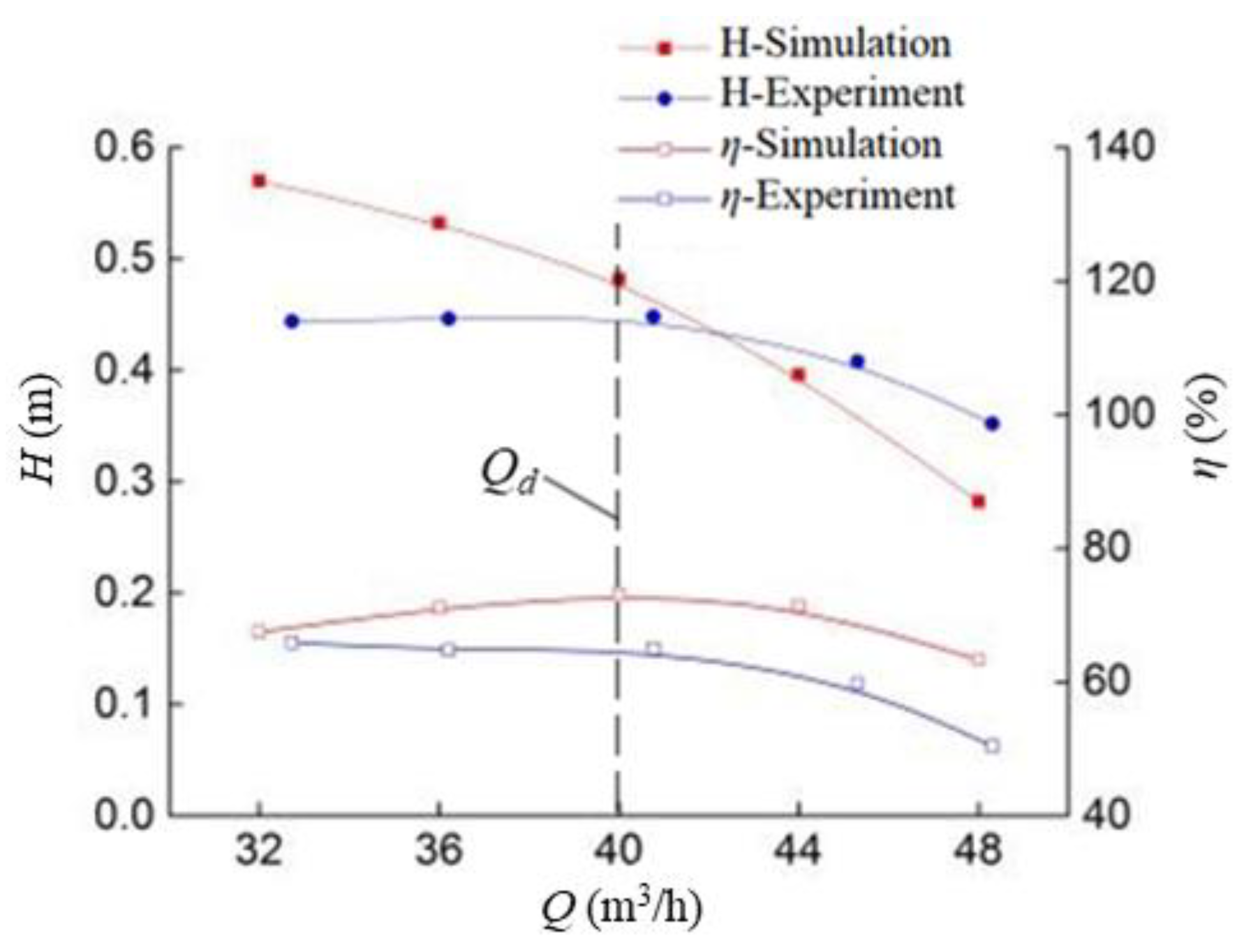


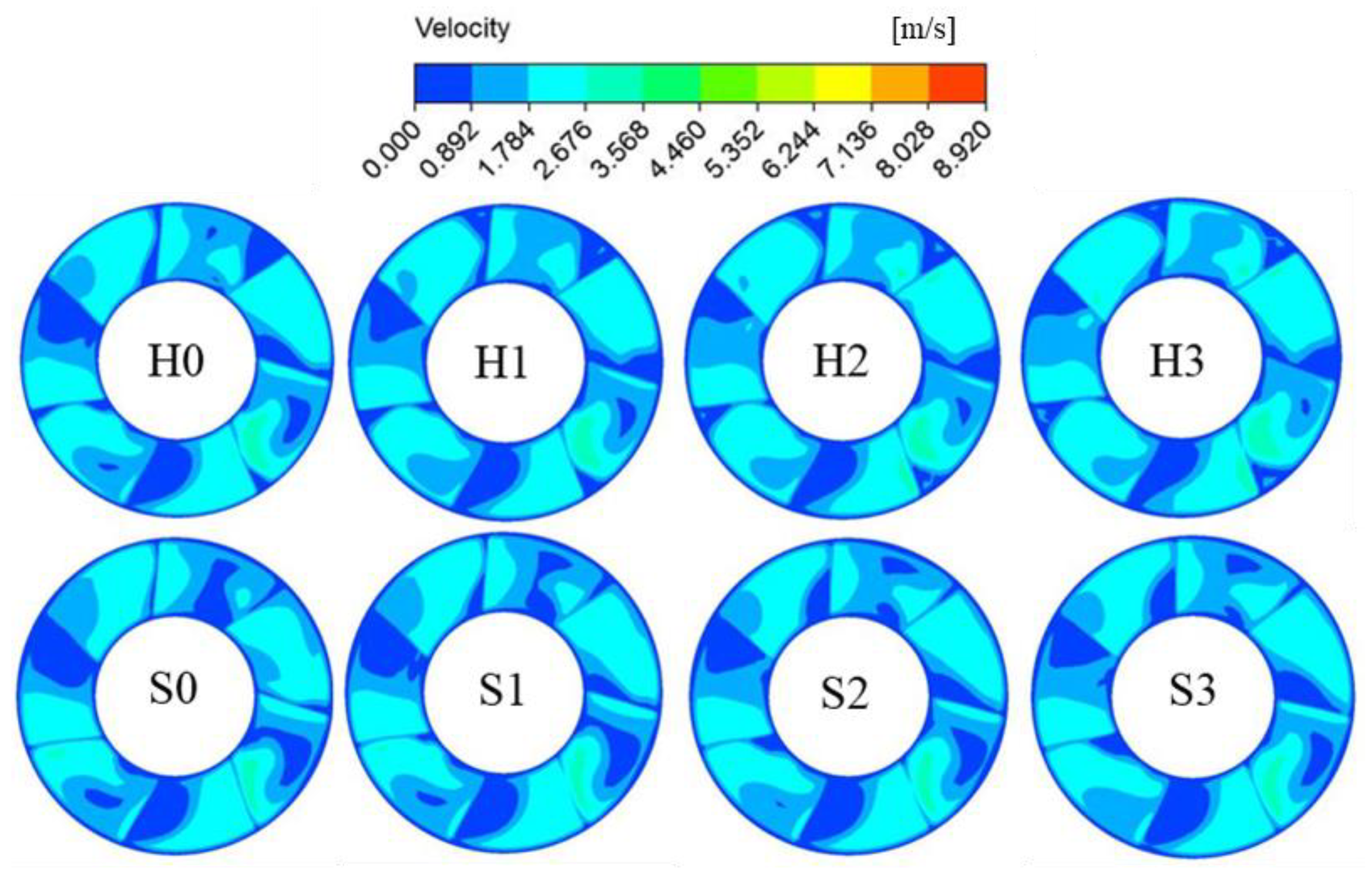
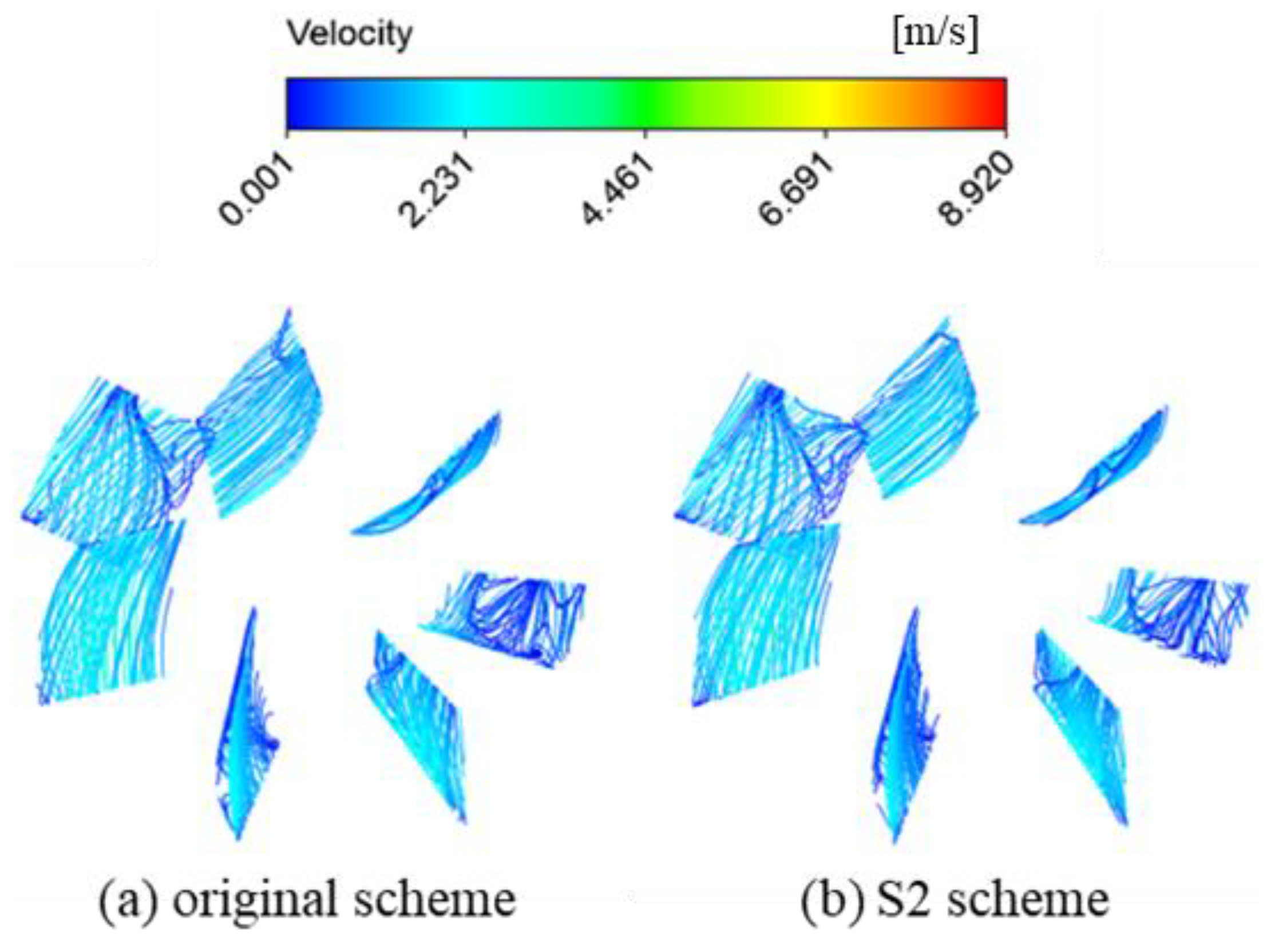
| Scheme | Grid Number | Head/m | Efficiency/% |
|---|---|---|---|
| 1 | 121,158 | 0.481455 | 72.1346 |
| 2 | 478,502 | 0.485106 | 73.2363 |
| 3 | 1,092,290 | 0.486309 | 73.8755 |
| Performance | H0 | H1 | H2 | H3 | S0 | S1 | S2 | S3 |
|---|---|---|---|---|---|---|---|---|
| Head/m | 0.4786 | 0.4818 | 0.4822 | 0.4804 | 0.4792 | 0.4816 | 0.4851 | 0.4822 |
| Efficiency/% | 72.63 | 72.68 | 72.77 | 72.78 | 73.12 | 73.15 | 73.24 | 72.92 |
Publisher’s Note: MDPI stays neutral with regard to jurisdictional claims in published maps and institutional affiliations. |
© 2022 by the authors. Licensee MDPI, Basel, Switzerland. This article is an open access article distributed under the terms and conditions of the Creative Commons Attribution (CC BY) license (https://creativecommons.org/licenses/by/4.0/).
Share and Cite
Li, Y.; Song, Y.; Xia, S.; Li, Q. Influence of Guide Vane Slope on Axial-Flow Hydraulic Performance and Internal Flow Characteristics. Energies 2022, 15, 6103. https://doi.org/10.3390/en15176103
Li Y, Song Y, Xia S, Li Q. Influence of Guide Vane Slope on Axial-Flow Hydraulic Performance and Internal Flow Characteristics. Energies. 2022; 15(17):6103. https://doi.org/10.3390/en15176103
Chicago/Turabian StyleLi, Yue, Yiwei Song, Shengsheng Xia, and Qiang Li. 2022. "Influence of Guide Vane Slope on Axial-Flow Hydraulic Performance and Internal Flow Characteristics" Energies 15, no. 17: 6103. https://doi.org/10.3390/en15176103






